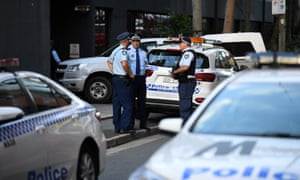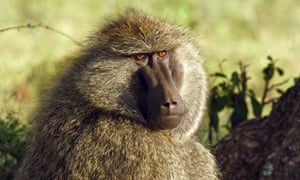Three baboons escaped while being transported to a hospital where one was due to have a vasectomy. Where did they come from, and what kind of research is performed on them?
The escape of three baboons from a Sydney hospital on Tuesday has sparked renewed calls for greater transparency in medical testing on animals in Australia and prompted the federal health minister to make a public statement in favour of polygamy among primates.
The baboons – a 15-year-old male who was scheduled to have a vasectomy, and two females brought along to keep him calm — escaped in the car park of the Royal Prince Alfred hospital on Tuesday afternoon, causing localised alarm and widespread bafflement.
Many questions were left unanswered after their swift recapture by staff from Taronga Zoo.
Much of the medical research using the baboons is conducted at an animal research laboratory at the RPA. The vasectomy was due to be carried out by specialist vets in an area of the RPA set up for veterinary surgery.
In a statement, NSW Health said it took the safety of animals and the public seriously.
“The animals were uninjured and have now safely returned to veterinary care and their families.”
The baboons – a 15-year-old male who was scheduled to have a vasectomy, and two females brought along to keep him calm — escaped in the car park of the Royal Prince Alfred hospital on Tuesday afternoon, causing localised alarm and widespread bafflement.
Many questions were left unanswered after their swift recapture by staff from Taronga Zoo.
Where did the baboons come from and how did they get out?
The baboons are part of the national baboon colony at Wallacia, 68km west of the Sydney CBD, which supplies baboons for scientific testing. Information about the colony is scant – the number of baboons at the facility is not publicly available and animal welfare organisations told Guardian Australia that requests to tour the facility have been refused.Much of the medical research using the baboons is conducted at an animal research laboratory at the RPA. The vasectomy was due to be carried out by specialist vets in an area of the RPA set up for veterinary surgery.
“The animals were uninjured and have now safely returned to veterinary care and their families.”
Colony management did not respond to requests for comment.
Helen Marston, the chief executive of Humane Research Australia, said she believed the number of baboons at the colony was “in the hundreds”.
Marston said she understood the baboons were kept in family groups in cages with some outside access, and “would have to be supplied with some environmental enrichment”, such as tyre swings and food toys.
All facilities involved in animal testing in NSW are inspected by authorities every four years. The details of those inspections are not published.
There are other primate colonies in Australia that breed animals for research purposes: a colony of marmosets and macaques in Gippsland, Victoria; and a colony of owl monkeys in Queensland used in malaria research.

These particular baboons are in a family group of seven – the three who escaped and four other females. The NSW health minister, Brad Hazzard, said the group would be reunited on Friday, after the male’s vasectomy, which was delayed by a day.
Hazzard said the male and “two of his wives” escaped due to a faulty lock on the truck. It’s unclear how many locks were between the baboons and freedom. Animal welfare experts told Guardian Australia it was unlikely the animals were loose in the back of the truck, but those details have not been made available.
The federal health minister, Greg Hunt, did not provide any further details but told reporters in Canberra his “heart was with the baboons”.
“They operated as a modern relationship and I’m fine with that,” Hunt said.
Hazzard said the baboons were “well and resting” after their foiled escape attempt and had breakfasted on bananas, capsicum, apple and bread.
He told reporters on Tuesday that the trio were not being transported for medical testing on this occasion.
“He was having a vasectomy because there’s no desire for him to continue to breed for the troop, and the other option was to move him from the troop,” Hazzard said. “This way, he can stay with his family through until old age.”
Hazzard said he understood baboons in the colony were “extremely well cared for”.
Marston said that even if these animals had not been used in animal testing, their offspring would have been.
Emma Hurst, an Animal Justice Party MP from NSW, said the animals “may have undergone multiple experiments and been involved in multiple protocols” over their lifetime.
Hurst said she hoped the escape would draw attention to the lack of transparency around the use of animals in medical testing in Australia.
“It’s possibly the least transparent animal-use industry that we have,” she said.
What do we know about the use of primates in medical testing?
According to figures collated by Humane Research Australia, 272 primates were used in “invasive experiments” in Australia in 2017. National figures are not compiled by any official body. South Australia, the Northern Territory and the ACT do not provide data.“We really do need the Australian government to collect these figures and provide them,” Marston said. “There is no benchmark to see if we are increasing the number of tests, there’s nothing. It’s just an estimate based on what we can get.”
The most common primate species used are baboons, macaques and marmosets. Australia does not allow medical or scientific testing on great apes.
According to the latest NSW data, 38 primates were used in research in NSW in 2017. The total number of animals involved in animal testing and research in that state in 2017 was 2.63m, of which 1.7m were involved in “environmental studies” and 1.6m were described as tests with “observation involving minor interference”.
Animal testing and research in NSW is overseen by the 12-member Animal Research Review Panel, of which the director of the baboon colony is a member. According to its 2017-18 annual report, there are 166 accredited animal research establishments and 34 licensed animal suppliers in NSW.
NSW Health said research on animals was subject to a “rigorous ethics process”.
“Animals are only used in medical research when it is scientifically warranted and there are no appropriate alternatives,” NSW Health said. “Research using non-animal systems such as computer or cell-based systems are used as a replacement for animal research where possible.”
According to published scientific studies, compiled by the HRA, tests involving baboons at the RPA included: the testing of radioactive material on four baboons; a blood pressure study involving 109 baboons as part of research into the effects of hypertension in pregnancy; a study involving nine baboons where researchers attempted to induce preeclampsia, which resulted in the death of one mother and one baby baboon; and a study on shoulder injuries which involved the surgical cutting of the shoulder tendons of eight baboons that were then euthanised to allow post-mortem study of the healing process.
The most controversial study involved the transplant of pig organs into baboons.
Dr Kevin Coleman, a retired GP who also worked in public health, is a member of a group that opposes the continued use of animal experiments at RPA and holds regular protests at the hospital on the first Friday of the month.
Coleman said he was concerned about the public health risks posed by xenotransplantation (the transplanting of organs from one species to another) in particular, and the animal testing in biomedical research more broadly.
Prof Peter Collignon, an infectious diseases specialist from the Australian National University, has also raised concerns about the risk of zoonotic diseases from xenotransplantation. He told Guardian Australia those concerns were particularly relevant as the world grapples with another coronavirus outbreak.
“If something is there [in the transplanted organ] that we don’t know about, that could be not only a disaster for the person who has the transplant, that could be a public health crisis,” Collingon said.

No comments:
Post a Comment